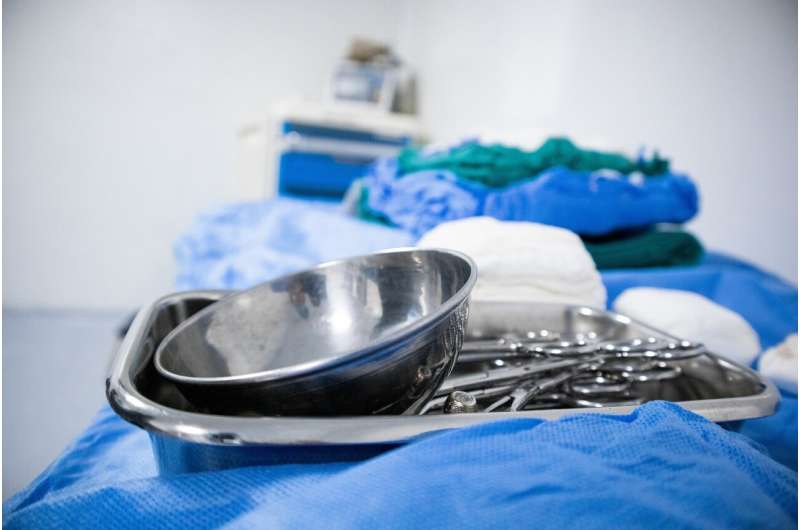This article has been reviewed according to Science X's editorial process and policies. Editors have highlighted the following attributes while ensuring the content's credibility:
fact-checked
reputable news agency
proofread
What patients can ask surgeons to help prevent a particularly harmful error

When a surgeon accidentally leaves a surgical tool inside a patient's body after a procedure, the harm can be severe. The patient can suffer from life-threatening infections, organ damage, and an additional surgery to remove the object.
This type of medical error is extremely rare. But it does happen:
An Inquirer investigation identified 203 cases in which patients at 39 Philadelphia-area hospitals received treatment related to a surgical item accidentally left inside their bodies during a procedure, according to an analysis of Pennsylvania hospital billing records from 2017 through 2022.
Patient safety experts say a single case is one too many. Government health regulators call these medical errors "never events" because they should never happen.
Sponges used to sop up blood during surgery are the most common item erroneously left inside patients. Another frequently missed item is a broken catheter fragment, said Marcus Schabacker, president of ECRI, a national nonprofit organization aimed at improving patient safety in Plymouth Meeting, Pennsylvania.
Schabacker, an anesthesiologist and intensive care specialist, is not your typical patient. He prefers to stay awake under local anesthesia and watch to make sure surgical teams don't mistakenly leave catheter parts or other objects behind. "If you are conscious, you can say, 'Hey, did you remove the whole thing?'" Schabacker said.
Most patients don't stay awake during surgery, but can still take steps to protect their own safety. For example, Schabacker recommends that patients familiarize themselves with safety measures that hospitals employ to prevent objects being left behind and talk to their surgeon before the procedure about which protocols will be followed.
The Inquirer spoke with Schabacker and Carl Sirio, chief medical officer at Temple Health, about some of those safety measures.
Manual supply counts
A designated operating room staffer, typically a nurse, counts all items. This includes a count of sponges and instruments before, during and after the procedure (but before closing the incision). Protocols include:
- Surgical instruments should be arranged carefully on trays, each in a designated spot where it must be returned after a surgeon uses it and hands it back.
- Surgical teams should have a "time out" before and after the procedure to confirm that counts are correct and that all items are accounted for.
- For all counts, one nurse should count aloud, as two other OR staffers watch. Typically, an operating room has a "circulating nurse" to help provide oversight. All used and counted items should ultimately be placed into a designated container.
- Staff should count supplies in bundles of 10 to reduce the likelihood of a miscount.
Schabacker, however, noted that manual counts are time-consuming and more prone to mistakes, with an accuracy rate of 75 to 80%.
Radio frequency ID tags
Many hospitals use sponges, towels and other supplies with special tags that emit a radio frequency that can be detected with a special device, much like a security tag on clothing that will sound a security alarm if not removed at the register. Staff can use a handheld device to scan a patient's body to check for these tagged surgical items.
"It's very, very effective, but it's not cheap," Schabacker said. "You need proprietary gauzes and sponges and other materials."
Barcoding surgical items
A cheaper alternative is a computer-assisted barcoding system. Every sponge, piece of gauze, or other surgical tool gets barcoded and scanned before it's used. A nurse, using a handheld device, scans the barcoded object again when it is handed back. A computer tracks the count, which is displayed on a screen. The barcode scanner has about a 97% detection rate, according to Schabacker.
X-ray detection
If an item remains missing after other safety checks are completed, an X-ray should be taken while the patient remains on the table. A radiologist should read the X-ray immediately. The approach is more expensive, but has a high detection rate. An X-ray is a good option for high-risk surgeries, such as long procedures with multiple surgical teams, Schabacker said.
Clear communication among OR staff
Each hospital should have a universal protocol carried out "in every room, every day, every case," said Sirio of Temple Health. Hospital administrators also should foster a culture in which nurses and other OR staff feel comfortable speaking up if a surgeon breaks protocol or tries to take a shortcut. Likewise, patients should be encouraged to advocate for themselves if something doesn't feel right after the procedure.
2024 The Philadelphia Inquirer, LLC. Distributed by Tribune Content Agency, LLC.





















